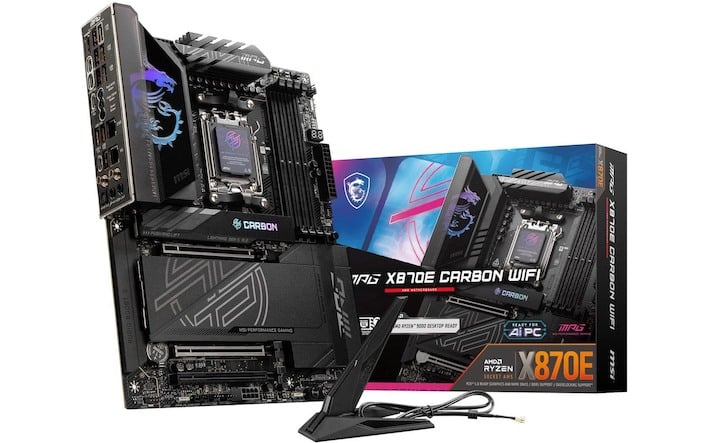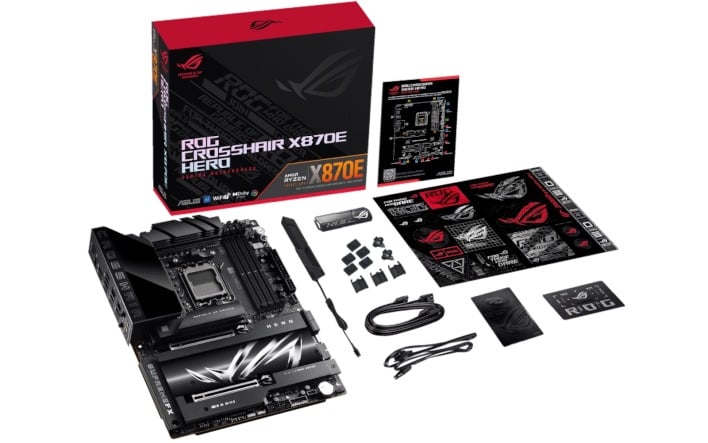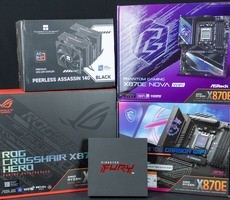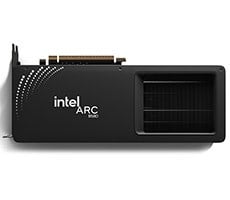One Issue With X870E—PCI Express Takes A Back Seat
We do have one big gotcha with all three of these motherboards to report, but it's not the fault of MSI, ASRock, or ASUS. Instead, the fault lies with AMD. The X870 chipset, including its X870E variant, is billed as the top-end chipset option for AMD's Socket AM5 platform. Naturally, given that, you would expect it to have the best connectivity available.
The reality is that, if you don't need USB4, AMD's mandate that all X870 and X870E motherboards must include USB4 connectivity is actually a little limiting for board vendors and DIY builders who might prefer to allocate those PCIe lanes to other devices. Take a look at this board diagram again, for the MPG X870E Carbon WiFi:
 Socket AM5 maximums: 24 PCIe 5.0, 12 PCIe 4.0, 8 PCIe 3.0
Socket AM5 maximums: 24 PCIe 5.0, 12 PCIe 4.0, 8 PCIe 3.0
If you examine the diagram with the socket AM5 limitations in mind, we can see that MSI has over-subscribed the PCIe 5.0 lanes from the CPU socket. There are only 24 lanes available, yet we've got two PCIe slots, two M.2 sockets, and an external USB4 controller all hanging off of the CPU socket. This means that if you want to make use of all of your M.2 sockets, you end up losing some performance from on your primary PCi Express slot.
We're not picking on MSI here, since almost every X870 and X870E motherboard has these kinds of compromises. MSI's Carbon board is one of just a handful of X870 or X870E motherboards that has more than one additional PCIe x4 slot beyond the x16 slot—because on most models, those extra lanes are occupied with the mandatory USB4 controller. Some boards, like MSI's own MAG X870 Tomahawk, allow you the option to disable the USB4 controller to improve the internal connectivity, but that's not a common feature; it's not available on any of the three boards we looked at today.
Don't get us wrong. USB4 is awesome and opens the door to a ton of great external devices. However, that's a lot more useful on SFF PCs and laptops than it is on a desktop machine, where a significant benefit of the form factor is, at least in theory, the ability to install internal upgrades.
Three Awesome AMD X870E Motherboards Analyzed
Click To Enlarge
Bringing this chart back, we can see at a glance what differences there are in these three boards. As you go up in price, you get more PCIe 5.0 connectivity and additional "nice to have" features, like 320-MHz Wi-Fi, the X870E Carbon's easily-accessed M.2 sockets, and the X870E Hero's high-quality audio DAC and Nitropath RAM slots.
Looking at the ASRock PG X870E Nova WiFi on its own merits, it's a full-featured motherboard with little to complain about, but it's important to keep things in perspective. At $350, this is already a pretty expensive board. We think you more or less get what you pay for here, but like with many premium purchases, it does become a little bit harder to justify the price increase as you step
up the product stack.
With that in mind, we think the ASRock PG X870E Nova WiFi offers the best value in the comparison thanks to its relatively low price and solid array of features. You get the same dual USB4 ports, the same PCIe 5.0 ×16 slot, the same 5-Gigabit Ethernet, the same ALC4082 audio, the same post code LEDs, the same BIOS Flashback, and the same 8-layer PCB as the other boards. If you're satisfied with what it offers, this board will server you well.
That's not to say that there's nothing to recommend the other two boards, though. In particular, the MSI MPG X870E Carbon WiFi has many qualities that endear it to us: gobs of high-speed USB connectivity, the best quick-access mechanism we've seen for its M.2 sockets, arguably the best-looking RGB LED accents, and the step up to 320-MHz Wi-Fi 7 are all notable improvements over the Nova.
Our only real issue with MSI's board is the mouse-driven Click BIOS X, but that's really down to personal preference. The $500 price tag might put it out of reach for some as well. It's a bitter pill to swallow if you're someone on a tight budget, but for folks who can responsibly spend top dollar on a PC, it makes complete sense to get a motherboard like MSI's X870E Carbon.
ASUS' ROG Crosshair X870E Hero is a little harder to justify. We want to be absolutely clear up front that we don't say this because it's a bad motherboard. In fact, this is one of the nicest boards we've ever tested. It's just that when you look at what it offers in comparison to the other two boards and then consider the price tag, it's hard to justify the additional premium.
That said, the ROG Crosshair X870E Hero does offer some extreme features, and qualifying and enabling those features doesn't come for free. This board offers unmatched control over the clocks and volts of every part of the machine, including ECLK support for the CPU and the ability to dynamically switch between an all-core manual overclock and AMD's automatic PBO for maximum single-core responsiveness. As such, if you're into XOC, this is probably the motherboard you want to get.
In The End, Buy For Features, Not For Speed
So after taking everything into consideration, what's our conclusion? The reality is that your motherboard is barely going to affect the performance of your system at stock settings, and the only reason to worry about performance is if you're an overclocker chasing benchmarks. In fact, even for most overclockers, the most affordable board in this comparison is likely to serve swimmingly, unless you're trying to push extremely high memory speeds or use LN2 cooling.
For everyone else, even the hardcore PC gamers out there, you should really be buying your motherboard based on its functions and features, not whether it will affect your performance. Outside of the very cheapest models out there—which may have weak VRMs that can't keep up with 12- and 16-core CPUs—virtually any Socket AM5 motherboard is going to give you nearly identical performance out of any Ryzen CPU.
Even the most-affordable board here is bristling with high-speed connectivity and high-quality components, so the three boards here may not illustrate our point clearly. However, in the mid-range and lower-end of the market, you need to be careful when picking a motherboard because the decision you make upon parting out your PC can have long-term consequences. For example, if you think "bah, I'll never need expansion slots" and buy a board with minimal or no PCIe expansion, you may be up a creek when you realize you actually want to use an internal capture card or some other add-in later.
Thanks again to ASRock, MSI, and ASUS for supplying the motherboards used in this comparison. Hopefully, it was informative. Make sure to leave us a comment below if you have a question, complaint, or have some input on these boards.











